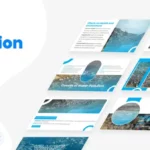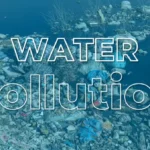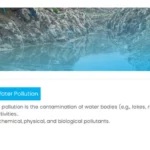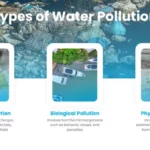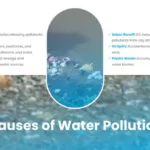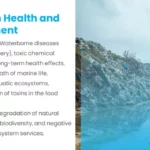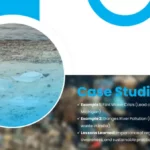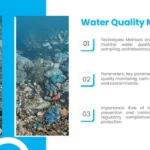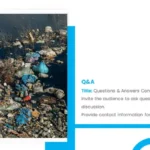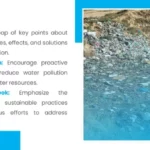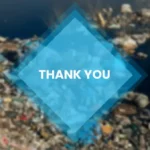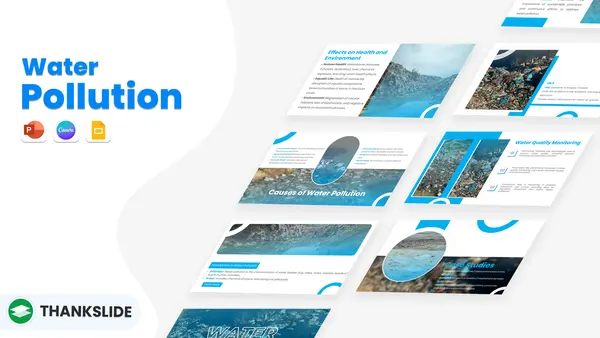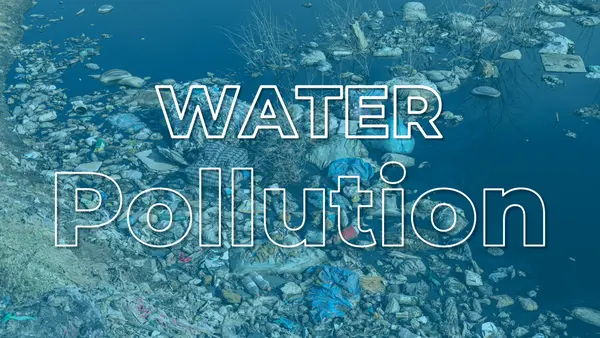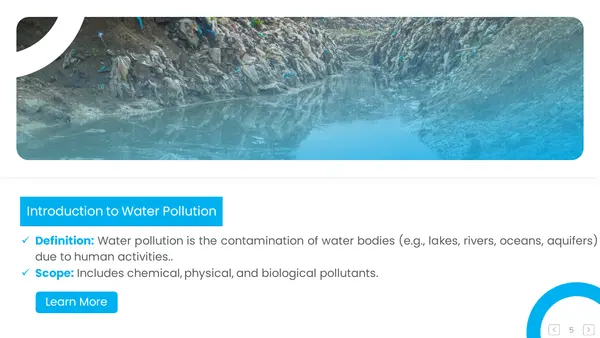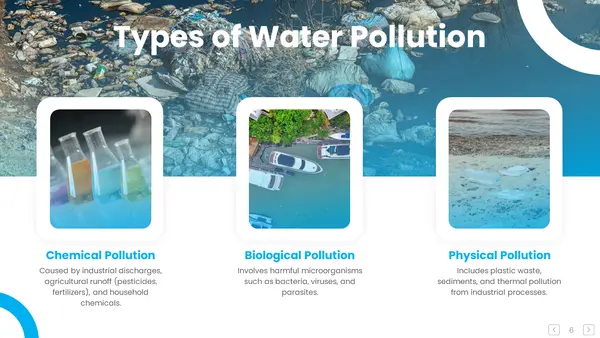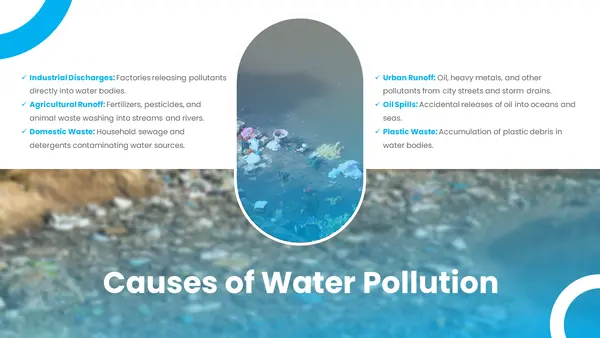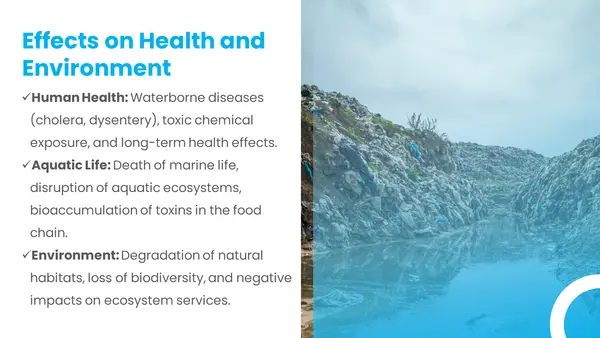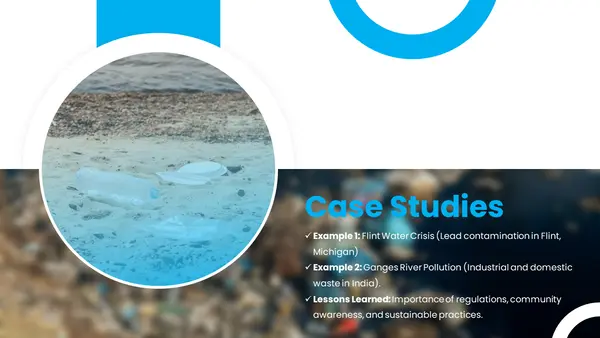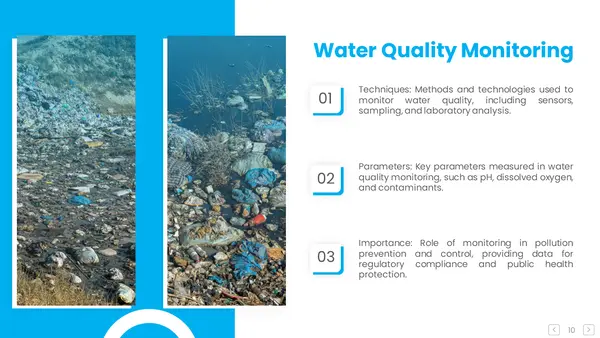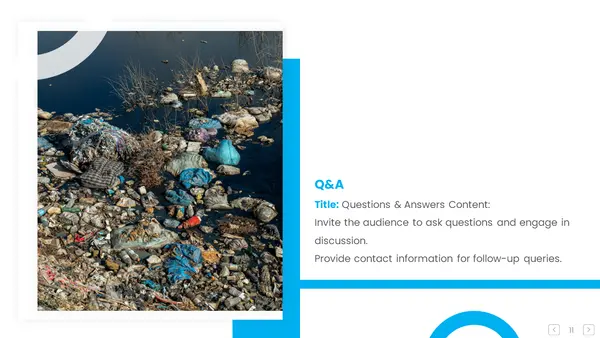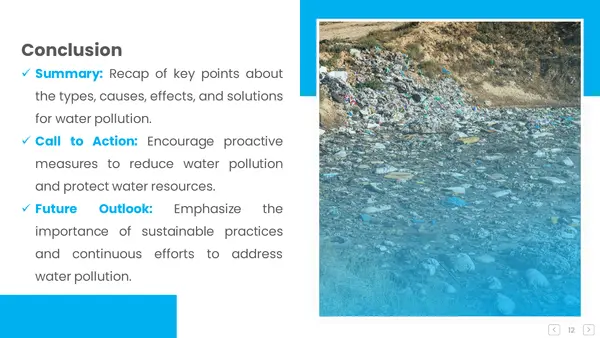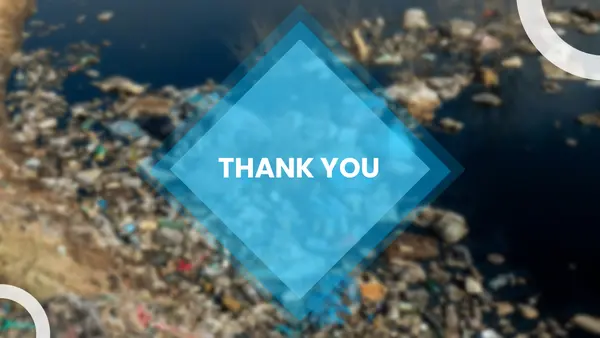Download Water Pollution Template
Water Pollution is a serious cause that demands immediate attention. The health of human life and the ecosystem is under the scanner because of Water Pollution. Water being an important aspect of human life we need to preserve it. This Blog Post delves into the definition, cause, types, and effects of Water Pollution.
Let’s examine the key factors related to Water Pollution, their Definition, their causes, their effects, and often asked questions about them.
You will get 13 slides of Water Pollution In PowerPoint, canva, and Google Slides.
Introduction (slide 05)
We’ve Considered the meaning that lets you know about Water Pollution in this slide.
When harmful substances of various types, such as chemicals, microorganisms, and plastic waste, contaminate a variety of water bodies like rivers, lakes, oceans, and groundwater, this contamination of water bodies is called water pollution. Contamination makes water unhealthy for the environment and unsafe for human use. Contamination further leads to serious effects on human health and the ecosystem.
The increase in industrial activities, urbanization, and agricultural practices has greatly led to the problem of water pollution, making it a critical issue that requires immediate attention.
This slide helps you effectively introduce the topic of water pollution. By using this slide you can build a strong foundation for the rest of the Presentation engaging the listeners.
Definition Of Water Pollution
(slide 05)
We’ve Considered the Definition and scope of Water Pollution in this slide.
Water Pollution is defined as the contamination of water bodies which leads to degradation of water quality. The contamination further leads to an unhealthy environment making it unsafe for human use as well as aquatic life. The seriousness of Water Pollution is global and affects almost every source of water across the globe. It includes a variety of pollutants such as chemicals, human waste, and garbage all of them leading to the degradation of water quality. The issue of water pollution extends beyond visible pollutants; it also includes invisible contaminants like pesticides, heavy metals, and pathogens that can have long-lasting effects on natural ecosystems and public health.
This slide allows you to offer an exact definition of water pollution which may help the listeners to clarify any preliminary confusion. It ensures that the audience understands the specific meaning of the term making it easier for you to present more complex topics.
Types of Water Pollution
(slide 06)
We’ve Considered the Types of Water Pollution in this slide.
Water Pollution can be categorized into three Different types –
- Chemical Pollution
- Organic Pollution
- Tangible Pollution
- Chemical Pollution
Contaminating water bodies with toxic substances from industrial in the form of industrial waste, agricultural waste, and household waste is termed Chemical Pollution. A few examples of chemical pollutants include heavy metals, pesticides, and Industrial chemicals. These substances can harm aquatic life and can also contaminate drinking water which can further lead to issues with human health
- Organic Pollution
When Water bodies are contaminated by disease-causing microorganisms such as bacteria, viruses, and parasites the pollution is organic pollution. Organic Pollution often results from the discharge from untreated or inadequately treated wastewater and agricultural runoff including animal waste. Organic Pollution can further lead to the spread of waterborne diseases resulting in significant threats to public health.
- Tangible Pollution
Pollution includes the addition of solid materials like plastics, silt, and debris to water bodies, such pollution is called Tangible Pollution. This type of pollution can obstruct rivers, clog water channels, and damage natural habitats. Plastics, in particular, are a growing concern as they can persist in the environment for hundreds of years and harm marine life.
By classifying water pollution into chemical, organic, and tangible types this slide helps you to address various aspects of the issue. It helps in arranging the presentation and makes it easy for the listeners to understand.
Causes of Water Pollution (slide 06)
We’ve Considered the Causes of Water Pollution in this slide. Water Pollution is caused by various human activities which contribute to the Contamination of water in different ways
- Industrial Discharge
Industries discharge large amounts of pollutants into water bodies, including chemicals, heavy metals, and waste. These discharges can alter the chemical composition of water, making it unsafe for drinking and harmful to aquatic life.
- Agricultural Contamination
Agriculture is a major source of water pollution. The use of pesticides, herbicides, and fertilizers in farming can lead to the contamination of nearby water sources through runoff. This runoff can carry harmful substances into rivers, lakes, and groundwater, affecting water quality and the diversity of aquatic life.
- Household Waste
Waste from homes contributes to water pollution through the release of untreated sewage and the use of products that can end up in water bodies. Improper disposal of waste, including medications and personal care products, can also pollute water.
- Urban Runoff
Urban areas are at risk of water pollution due to the presence of impermeable surfaces like roads and sidewalks. Rainwater runoff in these areas can carry pollutants such as oil, heavy metals, and trash into water bodies, causing pollution.
- Oil Disasters
Oil spills are a significant cause of water pollution, particularly in oceans. These spills can happen due to accidents involving oil tankers or offshore oil platforms. Oil spills can have devastating effects on marine life and coastal ecosystems, and can also have long-lasting impacts on water quality.
- Plastic Waste
Plastic waste is a major type of water pollution. Plastics can accumulate in water bodies, creating large areas of marine debris. This debris poses a threat to marine life, as animals can ingest or become entangled in plastic waste.
This slide equips you with a comprehensive list of causes for water pollution, which can be used to explain the origins of the problem. It provides a clear outline of how various human activities contribute to pollution, helping you to make a compelling case for why action is needed.
Effects of Water Pollution on health and environment (slide 08)
We’ve Considered the Effects of Water Pollution on health and the environment in this slide. Water pollution has serious effects on human health, marine life, and the environment
- Human Health
Contaminated water can lead to different well-being issues in people, including gastrointestinal issues, neurological clutters, and reproductive issues. Waterborne illnesses such as acute diarrhea, severe diarrhea, and typhoid fever are common in areas with poor water quality and inadequate sanitation. Long-term introduction to toxins in water can result in constant well-being conditions, including cancer.
- Marine Life
Water contamination has a noteworthy effect on oceanic environments. Toxins can alter the pH of water, causing the death of oceanic species and other sea-going life forms. Organic pollutants can lead to the trend of diseases during the water period, but solid waste contamination can destroy the habitat and reduce biodiversity. Influence on the environment
- Environmental Effects
The effects of water pollution on the environment are beyond the ecosystem of water. The contaminated water affects the soil and affects the animals that depend on the water source. Disruptions to natural water processes can cause problems such as droughts, floods, and loss of wetlands.
This slide allows you to highlight the severe impacts of water pollution on human health and the environment. It provides concrete examples of these effects, which can be powerful in emphasizing the urgency of the issue.
Case Studies (slide 09)
We’ve Considered some famous case studies of water Water Pollution in this slide.
- Example 1: Flint Water Crisis (Lead contamination in Flint, Michigan)
Before Flint’s water crisis grabbed the nation’s attention, the city was already grappling with serious water problems. For more than a century, the Flint River, which flows through the city, served as an unofficial dumping ground for both treated and untreated waste from various local businesses—from carriage and car factories to meatpacking facilities and sawmills. Moreover, the river received untreated sewage from the city’s wastewater treatment plant, agricultural runoff, and pollutants from leaking landfills. It was even rumored to have caught fire twice.
As these businesses grew, so did Flint’s economy. In the mid-20th century, Flint was a prosperous city, with nearly 200,000 people living there, many of whom worked in the thriving auto industry. However, the 1980s brought a downturn as increasing oil prices and the importation of cars led to the closure of auto plants and job losses. Flint’s population dropped to around 100,000, predominantly Black, with many living in poverty and a large number of homes left abandoned.
By 2011, with a $25 million budget shortfall, Flint was under the control of the state. In 2013, an emergency manager chose to switch to Detroit’s treated water for financial reasons, while a new pipeline from Lake Huron was being built. Unfortunately, the river water was corrosive and not properly treated, causing lead to seep into thousands of homes.
- Example 2: Ganges River Pollution (Industrial and domestic waste in India)
The Ganges, the largest river in the Indian subcontinent, is plagued by severe pollution issues that endanger both human health and the environment. It provides water to about 40% of India’s population across 11 states, supporting an estimated 500 million people, more than any other river in the world. However, the river is extremely polluted by human waste along with industrial contaminants earning it the status of being the most contaminated river in the world Over 600 km (370 mi) of the river is considered ecologically dead.
About 75% of the sewage from the northern plains is not treated before being dumped into the Ganges and its tributaries. Various cleanup efforts have been made, but they have had limited success. Following his election, Prime Minister Narendra Modi pledged to improve the river’s condition, which led to the initiation of the Namami Ganga project in June 2014. Despite spending approximately Rs 30 billion (US$460 million) in 2016, the project made little progress.
Suggested solutions include removing upstream dams to increase the river’s flow during dry seasons, constructing new dams or coastal reservoirs to help dilute pollution, and investing in significant infrastructure for the treatment of sewage and industrial waste. However, options like coastal reservoirs would be expensive and would require a lot of pumping to effectively dilute the pollution in the Ganges.
Presenting case studies provides you with real-world examples that illustrate the practical implications of water pollution. These examples can make the issue more relatable and compelling for the audience.
Water Quality Monitoring (slide 10)
We’ve Considered Water Quality Monitoring in this slide.
Water Quality monitoring is vital for identifying as well as controlling Contamination. It involves the use of various techniques and parameters to evaluate the well-being of Water bodies.
- Techniques
Approaches for evaluating the quality of water include gathering samples, conducting laboratory tests, and utilizing remote monitoring devices. Gathering samples involves pulling water from different locations for analysis of contaminants. Laboratory tests can identify various types of pollutants, including chemical, organic, and solid substances, while remote monitoring devices provide detailed insights into the condition of water bodies.
- Parameters
Key signs for determining the quality of water include pH levels, the presence of dissolved oxygen, clarity, and the identification of specific pollutants like nitrogen and phosphorus compounds, as well as harmful metals. These signs are important for assessing the level of pollution and the overall health of the water source.
- Importance
The importance of evaluating water quality cannot be overstated for the protection of public health and the preservation of natural environments. It aids in pinpointing the sources of pollution, assessing the effectiveness of pollution control measures, and ensuring compliance with environmental regulations. Regular monitoring also offers valuable data for researchers and policymakers aiming to develop sustainable water management plans.
This slide gives you the tools to explain how water quality is assessed and monitored. It helps in showcasing the importance of ongoing evaluation and can support discussions on how to improve water quality.
Conclusion (slide 12)
The issue of water contamination is a global concern that requires immediate and continuous attention. The pollution of water bodies by industrial, agricultural, and domestic activities has far-reaching consequences for human health, aquatic life, and ecosystems. Effective evaluation of water quality and the implementation of pollution control strategies are essential steps in mitigating the impacts of water pollution. It is our responsibility as individuals and communities to reduce our contribution to water pollution and advocate for policies that protect our water sources.
Call to Action
Take part in the fight against water pollution by supporting initiatives that promote clean water, reduce the use of plastics, and encourage sustainable agricultural and industrial practices. Spread awareness about the importance of protecting our water resources and participate in local clean-up initiatives.
Future Outlook
In the years ahead, advancements in technology and a heightened focus on environmental conservation will be crucial in addressing water pollution. By adopting innovative techniques and fostering global cooperation, we can work towards a future where clean, safe water is accessible to all.
The conclusion slide allows the presenter to summarise the key points and reinforce the overall message of the presentation. It helps in effectively closing the discussion and motivating the audience to take action. This slide also provides a platform for the presenter to deliver a clear call to action and outline the future outlook, ensuring that the audience leaves with a strong understanding of the issue and potential next steps.

